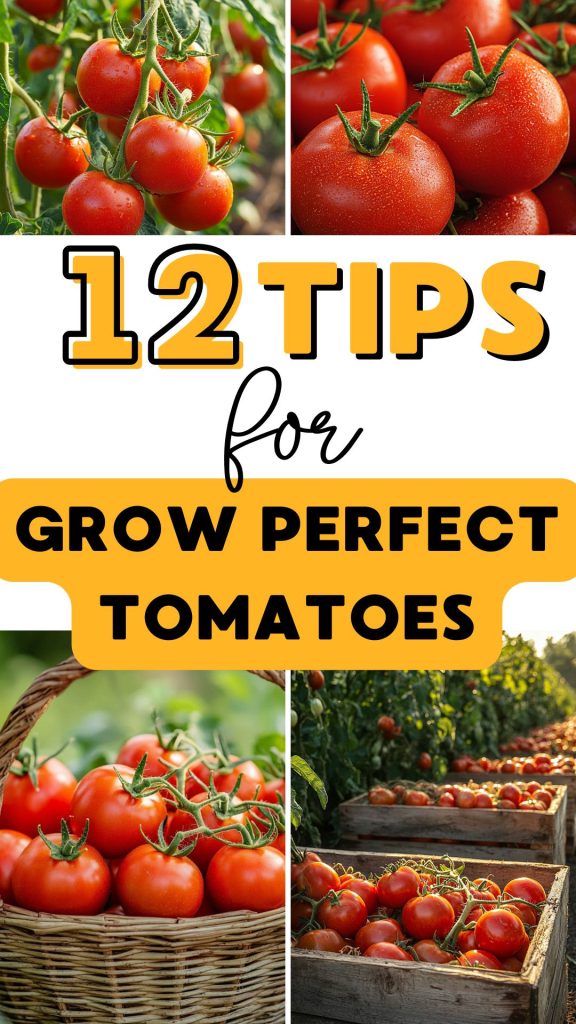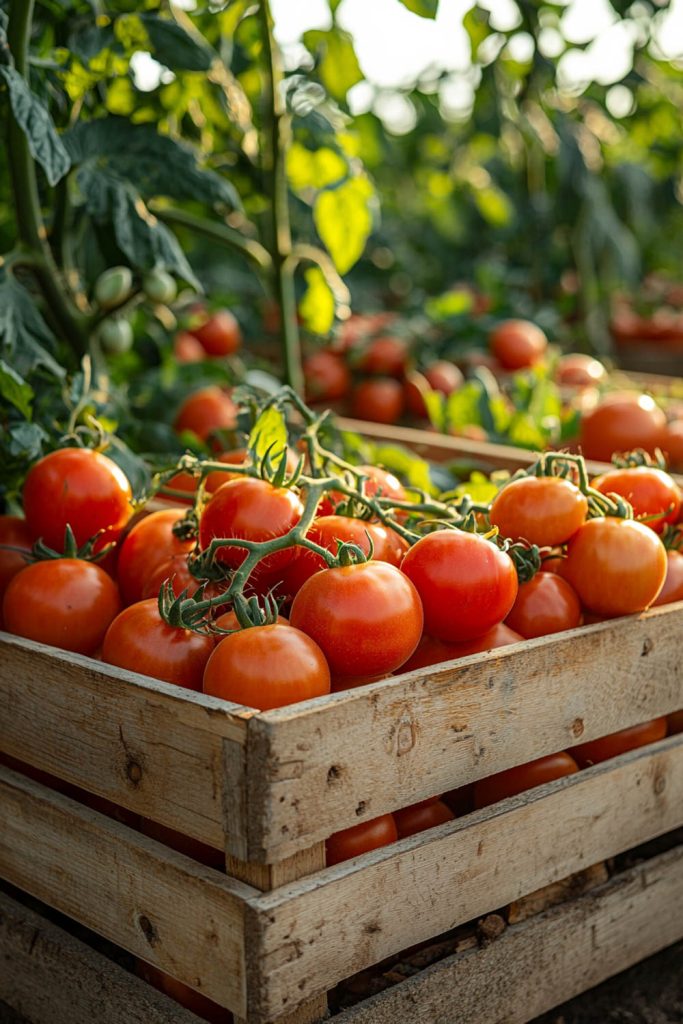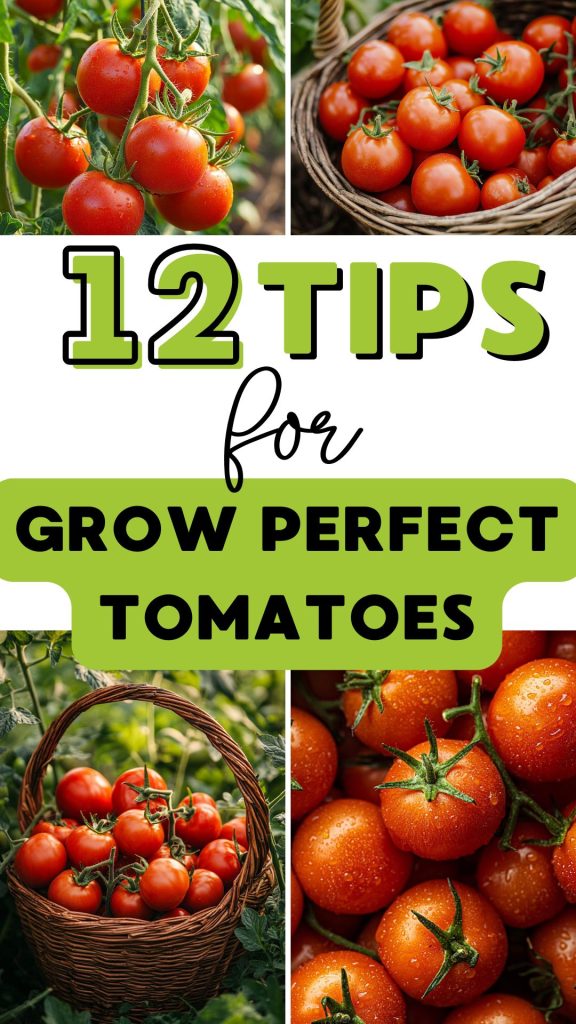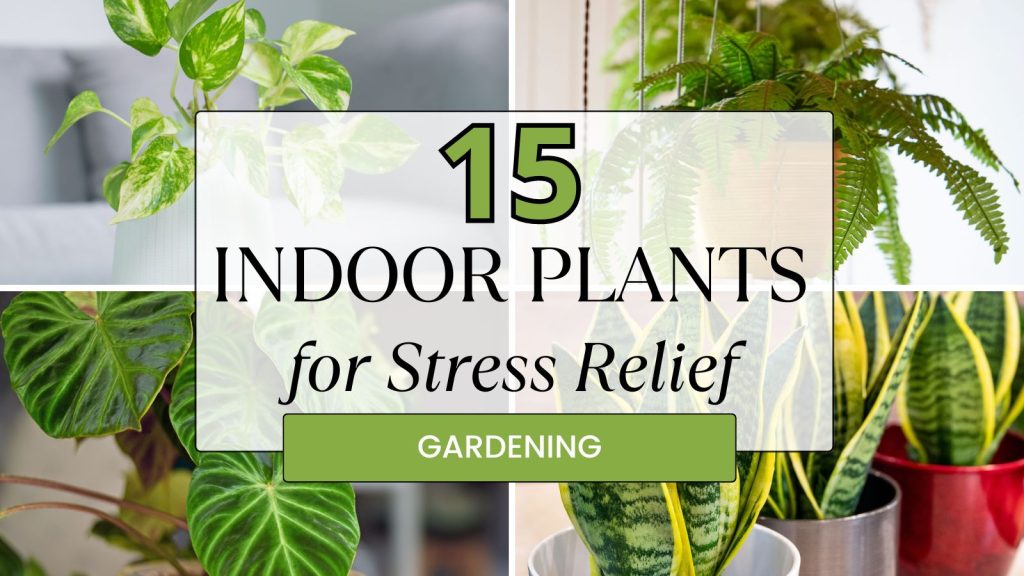Discover the top 12 gardening tips for growing perfect tomatoes in your vegetable garden, including the right temperature, soil, and light requirements for a bountiful harvest.

Tomatoes are the crown jewel of any vegetable garden. There’s nothing quite like the taste of a sun-ripened tomato picked fresh from the vine. But to grow those perfect, juicy tomatoes, you need more than just a green thumb—you need the right know-how.
So, let’s dive into 12 essential gardening tips that will help you cultivate the most vibrant tomatoes your vegetable garden has ever seen.
1. Choose the Right Tomato Varieties
When it comes to tomatoes, variety matters! Selecting the right type can make all the difference in your success.
Consider Your Climate:
- Cooler Climates: Opt for early-maturing varieties like ‘Early Girl’ or ‘Stupice’ that can thrive even in shorter growing seasons.
- Hotter Climates: Heat-tolerant varieties like ‘Heatmaster’ or ‘Solar Fire’ are designed to set fruit even in the heat of summer.
Space Considerations:
- Limited Space: If you’re short on space, consider dwarf or determinate varieties such as ‘Patio Princess’ that are ideal for container gardening.
- Ample Space: Indeterminate varieties like ‘Big Boy’ or ‘Beefsteak’ can grow quite large, making them perfect for sprawling vegetable gardens.
Taste Preferences:
- Sweetness: For those who love sweeter tomatoes, try varieties like ‘Sungold’ or ‘Sweet 100.’
- Acidity: If you prefer a more tangy flavor, varieties like ‘San Marzano’ or ‘Amish Paste’ might be more to your liking.
Gardening tips: Choosing the right variety tailored to your garden conditions and taste preferences is the first step towards tomato-growing success.

2. Start with Healthy Seedlings – Gardening Tips
Gardening tips: Healthy seedlings are the backbone of any successful tomato harvest. Ensuring your seedlings are in tip-top shape from the get-go sets your plants up for a bountiful yield.
Buy from Reputable Sources:
- Choose nurseries or garden centers known for high-quality, disease-free plants. Avoid seedlings that look weak, yellowing, or leggy.
Inspect Before You Buy:
- Look for signs of pests or disease, such as holes in leaves, discolored foliage, or wilting. Healthy seedlings should be green, robust, and have a sturdy stem.
Planting Tips:
- Depth: Plant seedlings deeper than they were in their pots, burying about two-thirds of the stem. This encourages root growth along the buried stem, resulting in a stronger plant.
- Spacing: Proper spacing (18-24 inches apart) is crucial for airflow and reducing the risk of disease.
Gardening tips: Starting with strong, healthy seedlings is like giving your tomatoes a head start on a winning season.
3. Ideal Soil Preparation
Gardening tips: Tomatoes are only as good as the soil they grow in. Preparing your soil properly can be the difference between a mediocre harvest and a bumper crop.
Soil Testing:
- Use a soil test kit to check your soil’s pH and nutrient levels. Aim for a slightly acidic pH of 6.2 to 6.8. If necessary, amend your soil with lime (to raise pH) or sulfur (to lower pH).
Organic Matter:
- Incorporate compost or well-rotted manure into the soil. This improves soil structure, drainage, and fertility, providing your tomatoes with the nutrients they need to thrive.
- Add a layer of compost (about 2-4 inches) to the topsoil and work it in to a depth of 6-8 inches.
Mulching:
- After planting, mulch around your tomatoes with straw, shredded leaves, or grass clippings. Mulch helps retain moisture, keeps weeds at bay, and regulates soil temperature.
Gardening tips: Proper soil preparation lays the groundwork—literally—for a healthy and productive tomato garden.
4. Proper Spacing for Airflow
Giving your tomato plants enough space to breathe is crucial for preventing disease and promoting healthy growth.
Spacing Guidelines:
- Determinate Varieties: Space these compact plants about 18 inches apart. They grow to a fixed size and produce fruit all at once.
- Indeterminate Varieties: These need more room, about 24-36 inches apart, as they continue growing and producing fruit throughout the season.
Air Circulation:
- Good airflow helps keep the foliage dry, which reduces the risk of fungal diseases like blight. This is especially important in humid climates.
- Avoid overcrowding by planting your tomatoes with sufficient spacing and consider removing the lower leaves to improve air circulation.
Row Orientation:
- If possible, plant your rows north to south to maximize sun exposure and airflow.
Gardening tips: By properly spacing your tomato plants, you can ensure they get the airflow they need to stay healthy and productive.
5. The Importance of Temperature – Gardening Tips
Tomatoes are warm-weather plants that need the right temperatures to flourish.
Ideal Planting Time:
- Wait until nighttime temperatures consistently stay above 50°F (10°C) before planting your tomatoes outdoors. Planting too early, when the soil is still cold, can stunt growth and delay fruiting.
Temperature Extremes:
- Cold: If the temperature drops below 55°F (13°C), tomatoes may struggle to set fruit. Use row covers or cloches to protect young plants from unexpected cold snaps.
- Heat: When temperatures soar above 85°F (29°C), tomato flowers may fail to pollinate, leading to a drop in fruit production. In extreme heat, providing some shade or using shade cloth can help protect your plants.
Soil Temperature:
- Tomatoes prefer warm soil (above 60°F/16°C). Black plastic mulch can help raise soil temperatures early in the season.
Gardening tips: Understanding the temperature needs of your tomatoes ensures they grow vigorously and produce fruit reliably.
6. Watering Wisely – Gardening Tips
Gardening tips: Tomatoes need a consistent water supply, but it’s important not to overdo it. Too much or too little water can lead to a variety of problems.
Consistent Moisture:
- Tomatoes need about 1-2 inches of water per week, delivered in a consistent manner. Fluctuating moisture levels can lead to issues like blossom end rot, where the bottom of the fruit turns black and leathery.
- Water your plants deeply at the base rather than overhead, which can encourage disease on the leaves.
Morning Watering:
- Water your tomatoes in the morning so that any moisture on the leaves can dry off during the day. This reduces the chances of fungal infections.
- If you can, use drip irrigation or soaker hoses to deliver water directly to the roots while keeping the foliage dry.
Mulching for Moisture Retention:
- A 2-3 inch layer of mulch helps retain soil moisture and keeps the root zone cooler during hot weather.
Gardening tips: By watering wisely, you’ll help your tomato plants develop strong root systems and avoid many common growing issues.
7. Fertilize at the Right Time – Gardening Tips
Tomatoes are heavy feeders and benefit from regular feeding throughout the growing season.
Starting Fertilization:
- Begin with a balanced fertilizer (like 10-10-10) when planting. This provides your plants with the necessary nutrients to establish strong roots and foliage.
Transition to Phosphorus and Potassium:
- Once your plants start to flower, switch to a fertilizer higher in phosphorus and potassium (like 5-10-10). These nutrients support blossom development and fruiting.
- Avoid excessive nitrogen, as it promotes leaf growth at the expense of fruit production.
Feeding Schedule:
- Apply fertilizer every 4-6 weeks during the growing season. Liquid fertilizers can be applied more frequently, following the manufacturer’s instructions.
Compost Tea:
- Consider feeding your plants with compost tea, a nutrient-rich solution made by steeping compost in water. This can be used as a foliar spray or soil drench to give your tomatoes an extra boost.
Gardening tips: Proper fertilization ensures that your tomatoes have all the nutrients they need for healthy growth and abundant fruit production.
8. Prune for Better Production
Pruning helps your tomato plants focus their energy on producing fruit rather than excessive foliage.
Removing Suckers:
- Suckers are the small shoots that develop in the crotch between the stem and a leaf branch. While not harmful, they can divert energy away from fruit production. Pinch them off regularly to encourage a stronger, more productive plant.
Pruning Lower Leaves:
- As your plant grows, remove the lower leaves that are close to the ground. This improves air circulation and reduces the risk of soil-borne diseases splashing onto the leaves.
Topping the Plant:
- Towards the end of the season, consider “topping” your plants by cutting off the top of the main stem. This redirects the plant’s energy into ripening the existing fruit rather than producing more flowers.
Using Pruning Tools:
- Use clean, sharp pruners to avoid damaging the plant. Always disinfect your tools between plants to prevent the spread of disease.
Gardening tips: Regular pruning helps your tomato plants produce larger, more flavorful fruits by directing energy where it’s needed most.
9. Support Your Plants – Gardening Tips
Gardening tips: Tomato plants need support to stay upright, especially as they become laden with fruit.
Types of Support:
- Stakes: Wooden or metal stakes are an economical option. Drive the stake into the ground about 6 inches from the plant and tie the main stem to it as the plant grows.
- Cages: Tomato cages provide support on all sides, which is especially beneficial for larger, indeterminate varieties. Choose sturdy cages that won’t collapse under the weight of the fruit.
- Trellises: A trellis can support multiple plants and is a good choice for those with limited garden space.
Tying Techniques:
- Use soft ties, such as garden twine or strips of old fabric, to secure the plants to their supports. Tying too tightly can damage the stems, so leave a little slack for the plant to grow.
Adjust as Needed:
- As your tomato plants grow, you’ll need to adjust the ties and add more support. Check your plants regularly and make adjustments to keep them upright and healthy.
Gardening tips: Supporting your tomato plants not only helps prevent fruit from rotting on the ground but also makes harvesting easier and reduces the risk of disease.
10. Watch for Pests and Diseases – Gardening Tips
Tomatoes can be susceptible to a variety of pests and diseases, but with a little vigilance, you can keep these problems in check.
Common Pests:
- Aphids: These tiny insects suck sap from the plant and can be controlled with insecticidal soap or by introducing beneficial insects like ladybugs.
- Tomato Hornworms: These large caterpillars can defoliate a plant in no time. Hand-picking them off the plant is an effective control method.
- Whiteflies: These pests can weaken plants by sucking sap. Yellow sticky traps can help reduce their numbers.
Disease Prevention:
- Blight: A common fungal disease that causes leaves to brown and die. Rotate crops annually to prevent soil-borne pathogens, and avoid overhead watering.
- Wilt Diseases: These include Fusarium and Verticillium wilt, which cause the plant to suddenly wilt. Selecting resistant varieties and ensuring good soil drainage can help prevent these issues.
- Powdery Mildew: This appears as a white powdery substance on leaves. Good air circulation and removing infected leaves can help control it.
Organic Solutions:
- Use neem oil, insecticidal soap, or a homemade solution of water and dish soap to treat infestations. Always test a small area first to ensure the treatment doesn’t harm the plant.
Gardening tips: By staying vigilant and treating problems early, you can keep your tomato plants healthy and productive all season long.
11. Ensure Proper Sunlight – Gardening Tips
Gardening tips: Sunlight is vital for tomato plants, as it drives photosynthesis and ensures healthy growth and fruit production.
Full Sun:
- Tomatoes need a minimum of 6-8 hours of direct sunlight per day. Inadequate sunlight will result in leggy plants and poor fruit production.
Choosing the Right Spot:
- Select the sunniest spot in your garden for planting tomatoes. If you’re growing in containers, place them in a location that receives full sun, such as a south-facing balcony or patio.
Shading in Hot Climates:
- In very hot climates, providing some shade during the peak afternoon hours can protect your plants from heat stress and prevent fruit from sunscald. Use shade cloth or plant taller crops nearby to provide dappled shade.
Reflective Mulch:
- Consider using reflective mulch to bounce sunlight back onto the plants. This can help increase light exposure, especially in partially shaded areas.
Gardening tips: Ensuring your tomatoes get plenty of sunlight is crucial for vigorous growth and a bountiful harvest.
12. Harvest at the Right Time – Gardening Tips
Harvesting tomatoes at the perfect time ensures you get the best flavor and texture.
Signs of Ripeness:
- Look for a deep, even color that is typical of the variety. The fruit should be slightly soft to the touch and release easily from the vine when gently twisted.
- Some varieties, like ‘Green Zebra,’ remain green when ripe, so it’s important to know the characteristics of the variety you’re growing.
Morning Harvest:
- Harvest tomatoes in the morning when they are coolest. This helps preserve their flavor and prolongs shelf life.
Storing Tomatoes:
- Store tomatoes at room temperature, away from direct sunlight. Refrigeration can dull their flavor and alter their texture. If you have more than you can use immediately, consider canning or making sauces to preserve the harvest.
Harvesting Green Tomatoes:
- If frost is imminent or your growing season is ending, harvest mature green tomatoes and allow them to ripen indoors. Place them in a paper bag with an apple or banana, which emits ethylene gas that helps ripening.
Gardening tips: Harvesting at the right time ensures you get the most delicious, homegrown tomatoes to enjoy fresh or preserve for later.
Tools and Gadgets for Tomato Gardening Success – Gardening Tips
Soil pH Tester: Ensuring your soil is within the ideal pH range is crucial for tomato health.
Tomato Cages/Stakes: Essential for supporting your plants and preventing disease.
Mulch: Helps retain soil moisture and keep weeds under control.
Row Covers: Protect your plants from unexpected cold snaps and pests.
Drip Irrigation Kit: Ensures consistent watering while minimizing water waste.
Final Thoughts – Gardening Tips
Growing perfect tomatoes in your vegetable garden isn’t just about planting and waiting—it’s a blend of science and art. With these 12 gardening tips, you’re well on your way to enjoying a bountiful harvest of delicious, homegrown tomatoes.
So, grab your gardening gloves, and let’s get growing!

For more gardening tips CLICK HERE!
Or check my Pinterest board about gardening.


